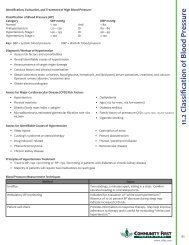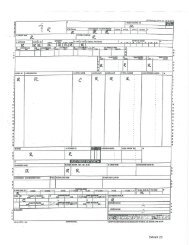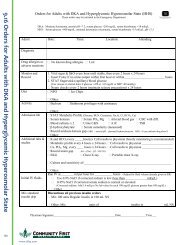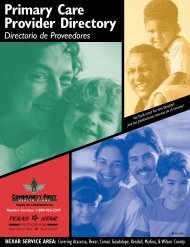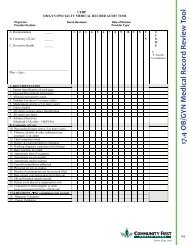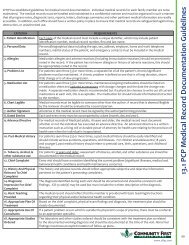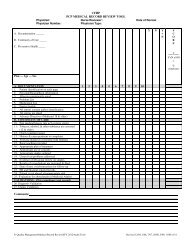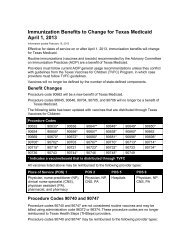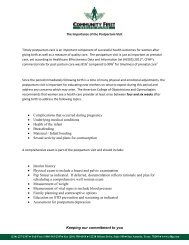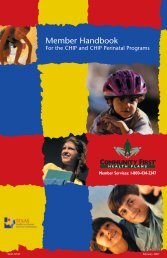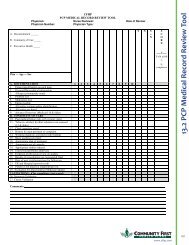Full Clinical Guidelines - Community First Health Plans.
Full Clinical Guidelines - Community First Health Plans.
Full Clinical Guidelines - Community First Health Plans.
Create successful ePaper yourself
Turn your PDF publications into a flip-book with our unique Google optimized e-Paper software.
19.2 Assessment, Prevention and Treatment of Pediatric Obesity<br />
Appendix: Expert Committee Recommendations on the Assessment, Prevention, and Treatment of Child and Adolescent<br />
Overweight and Obesity<br />
January 25, 2007<br />
Assessment Recommendations<br />
1. The Expert Committee recommends that physicians and allied healthcare providers perform, at a minimum, a yearly<br />
assessment of weight status in all children, and that this assessment include calculation of height, weight (measured<br />
appropriately), and body mass index (BMI) for age and plotting of those measures on standard growth charts.<br />
2. With regard to classification, the Expert Committee recommends that:<br />
a.<br />
Individuals from the ages of 2 to 18 years, with a BMI ≥ 95th percentile for age and sex, or BMI exceeding 30 (whichever<br />
a.<br />
is smaller), should be considered obese.<br />
Individuals with BMI ≥ 85th percentile, but < 95th percentile for age and sex, should be considered overweight, and this<br />
term replaces “at risk of overweight.”<br />
3. The Expert Committee recommends use of the 99th percentile of BMI for age cut-offs (indicate by using a table with<br />
cutpoints for the 99th percentile BMI by age and gender) to allow for improved accessibility of the data in the clinical<br />
setting and for additional study.<br />
4. The Expert Committee recommends against routine clinical use of skinfold thickness in the assessment of obesity in<br />
children.<br />
5. The Expert Committee was unable to recommend the use of waist circumference for routine clinical use at the present time<br />
because of incomplete information and lack of specific guidance for clinical application.<br />
6. The Expert Committee recommends that qualitative assessment of dietary patterns of all pediatric patients be conducted,<br />
at a minimum, at each well child visit for anticipatory guidance, and that assessment include the following areas:<br />
a.<br />
Self-efficacy and readiness to change:<br />
b.<br />
Identification of the following specific dietary practices, which may be targets for change<br />
i. Frequency of eating outside the home at restaurants or fast food establishments<br />
ii. Excessive consumption of sweetened beverages<br />
iii. Consumption of excessive portion sizes for age<br />
c.<br />
Additional practices to be considered for evaluation during the qualitative dietary assessment include:<br />
i. Excessive consumption of 100% fruit juiceii)<br />
ii. Breakfast consumption (frequency and quality)<br />
iii. Excessive consumption of foods that are high in energy density<br />
iv. Low consumption of fruits and vegetables<br />
v. Meal frequency and snacking patterns (including quality)<br />
7. The Expert Committee recommends that assessment of levels of physical activity and sedentary behaviors should be<br />
performed in all pediatric patients at a minimum, at each well child visit for anticipatory guidance, and should include these<br />
general areas:<br />
a.<br />
Self-efficacy and readiness to change<br />
b.<br />
Environment and social support and barriers to physical activity<br />
c.<br />
Whether the child is meeting recommendations of 60 minutes of at least moderate physical activity per day<br />
d.<br />
Level of sedentary behavior, which should include hours of behavior such as television and/or DVD watching, playing<br />
video games, and using the computer, and comparison to a baseline of



